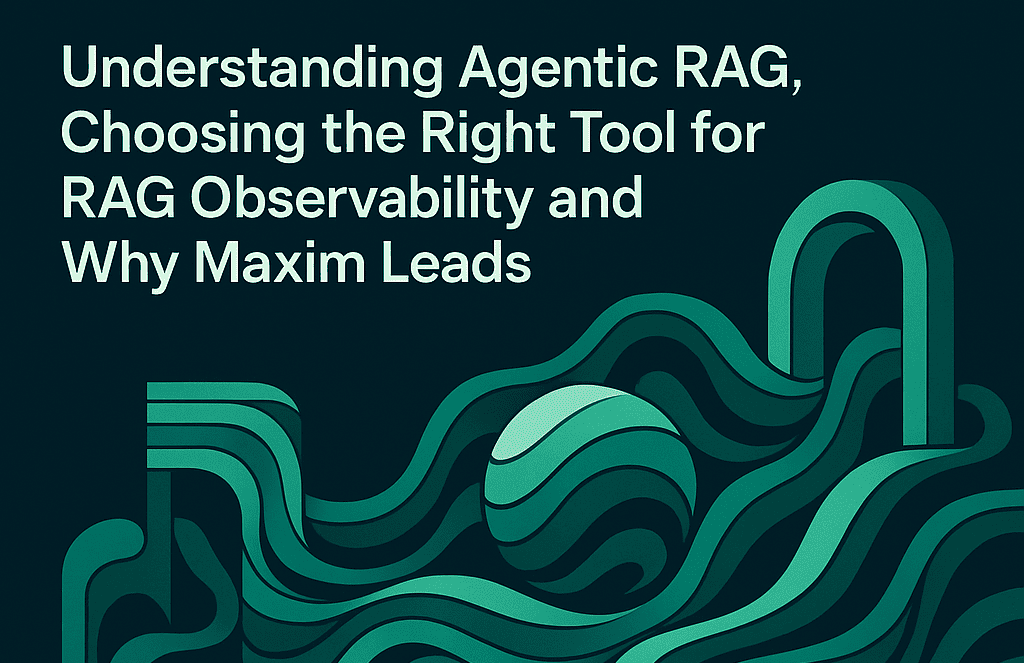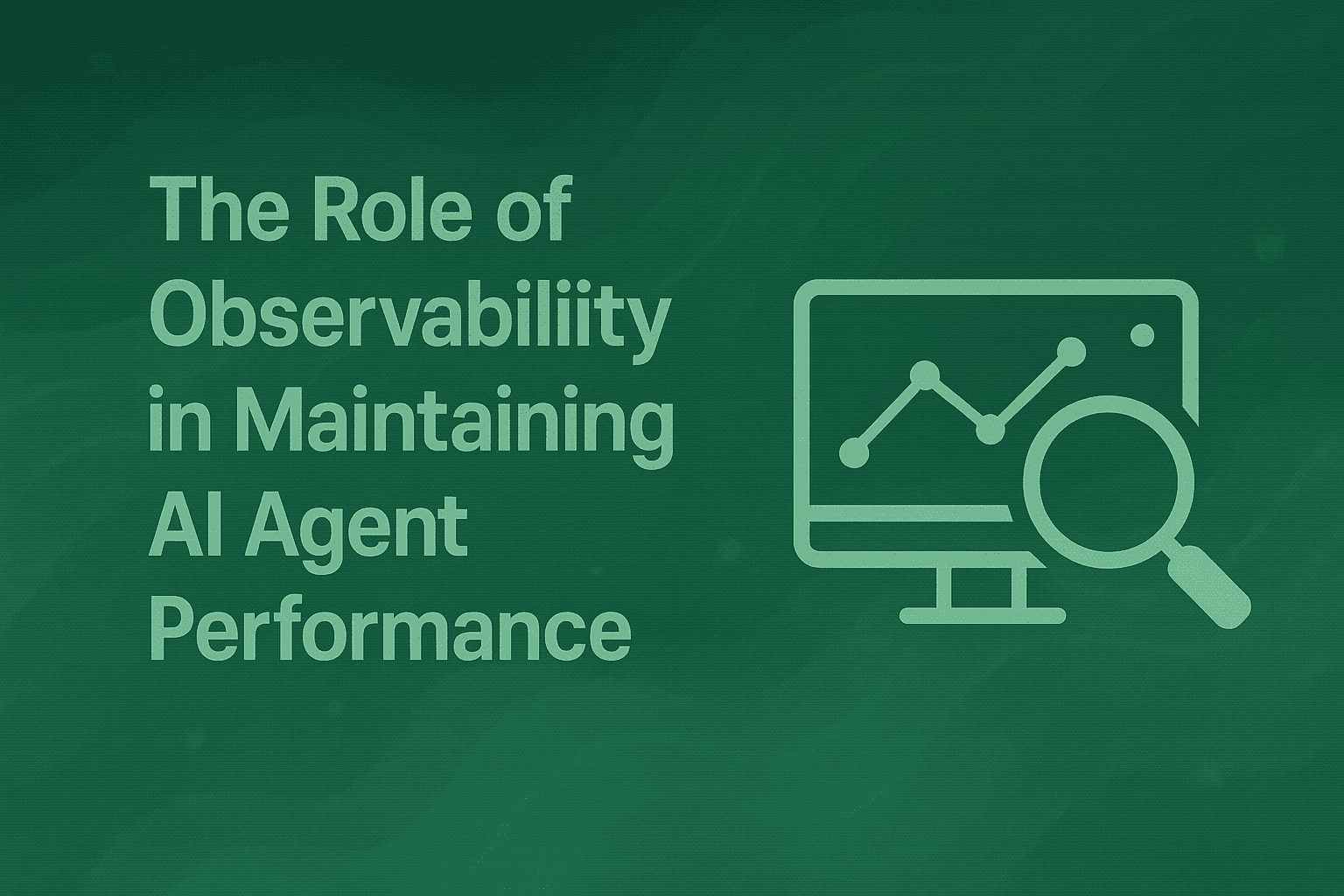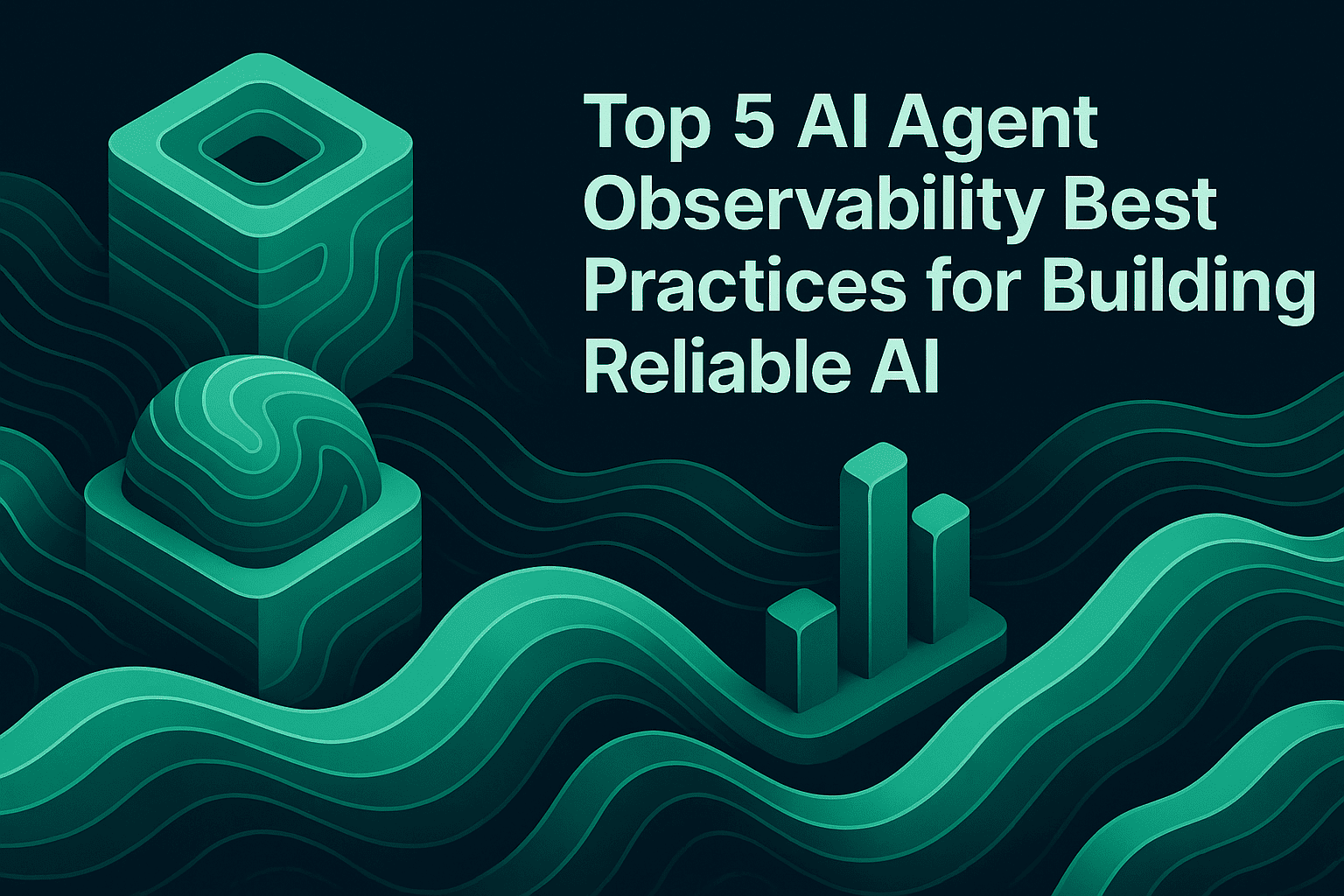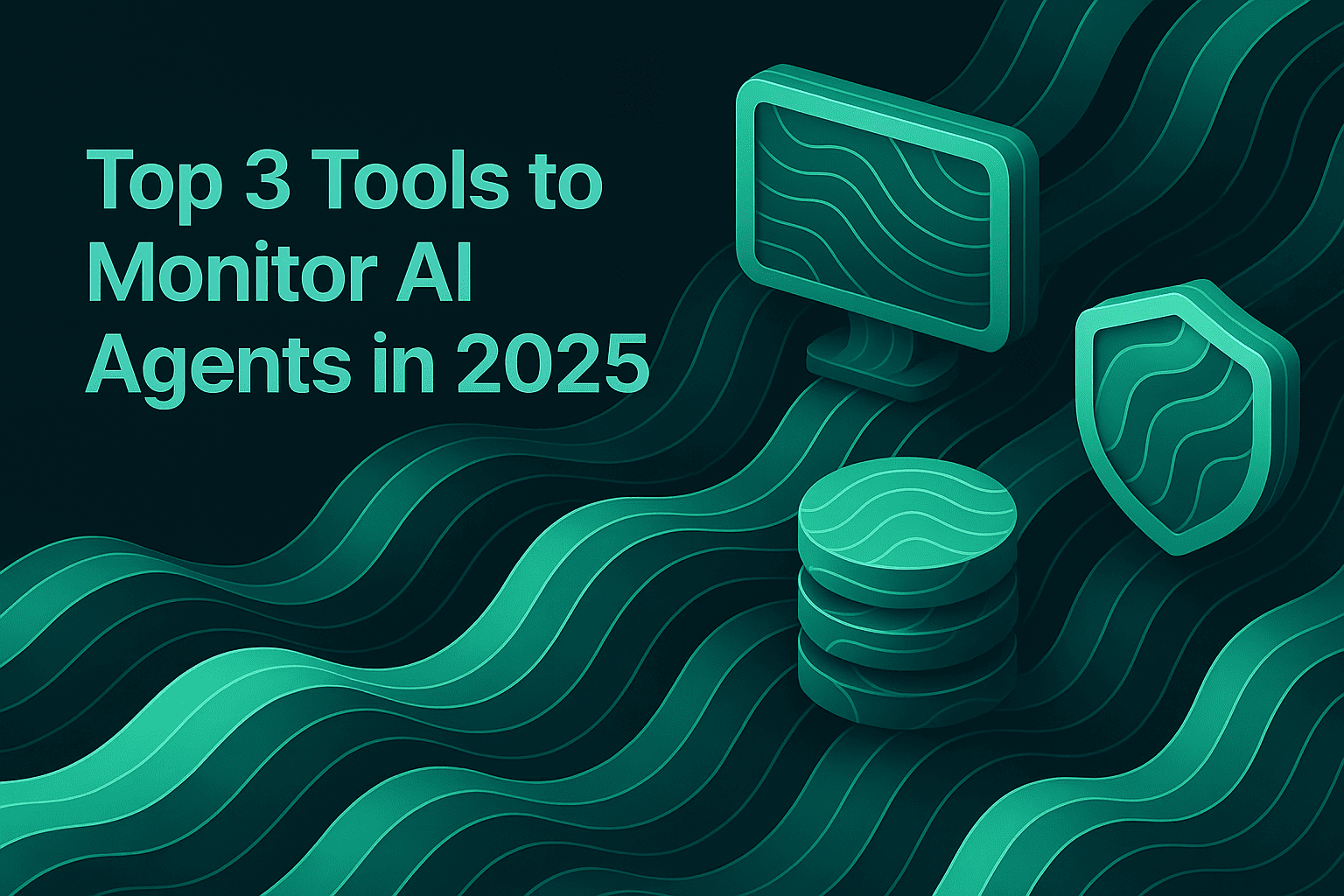Understanding Agentic RAG, Choosing the Right tool for RAG Observability and Why Maxim Leads

TL;DR
Agentic RAG adds autonomous reasoning to retrieval-augmented generation, and it demands rigorous observability: Maxim AI leads with unified simulations, RAG evaluation, and observability for AI reliability in production.
Agentic RAG blends retrieval-augmented generation with ai agents that plan, call tools, and adapt based on outcomes. The challenge is reliability. Retrieval can miss relevant context, agents can compound small mistakes across steps, and models may hallucinate when evidence is thin.To keep the system trustworthy, teams need visibility and measurement at every stage. Maxim AI provides a full-stack platform for agentic rag with distributed agent tracing, vector db observability, automated RAG evaluation metrics, governance, and simulation grounding quality from pre-release through production. See the discussion on prompt injection risks and defenses on Maxim AI and explore product docs at the Maxim docs.
What Is Agentic RAG?
Agentic RAG elevates basic RAG by employing ai agents that plan, reason, and act across multiple steps. Instead of a single pass, the agent decomposes tasks, issues retrieval queries iteratively, invokes tools, and updates its plan based on intermediate results. This agentic loop improves task completion and resilience in ambiguous or multi-turn scenarios.
Why Agentic RAG Observability is important?
Without distributed ai tracing, teams cannot localize regressions, calibrate relevance, or detect hallucinations early.
Agentic RAG systems share technical properties that require deeper agent observability:
- Multi-step planning: Agents form and revise plans, requiring detailed agent tracing and span-level metadata to understand decisions and failures.
- Adaptive retrieval: Agents adjust queries with reranking and reformulation; this demands vector db observability to monitor recall, precision, and drift.
- Tool integration: External tools introduce latency, failure modes, and governance needs; otel compatible traces capture the full context.
- Safety posture: Strong defenses against prompt injection and jailbreaking; see guidance on threat modeling at Maxim AI.
- Hallucination detection: Even with retrieval, LLMs can fabricate. Automated evaluators and human-in-the-loop reviews catch and quantify hallucinations.
- Quality drift: Embedding updates, corpus changes, or chunking strategies affect recall and precision vector db observability tracks these shifts over time.
- Routing and governance: Multi-provider setups introduce variability; centralized llm observability with budgets and policies ensures controlled deployments.
- Latency and cost control: Fine-grained traces expose slow spans, inefficient tools, and redundant retrieval, enabling optimizations without sacrificing quality.
- Compliance and auditability: End-to-end agent tracing supports audits and reproducibility, especially for regulated environments.
These systems require rigorous llm observability and application monitoring to maintain quality and reliability at scale.
How to Determine the Best Agentic RAG tool?
Selecting an Agentic RAG framework should balance architecture fit and operational maturity. Evaluate across:
- Observability depth: Native otel support, distributed traces, and structured span metadata across retrieval, rerank, and synthesis. Prioritize platforms that expose agentic rag tracing at the session and span level.
- Evaluation breadth: Built-in agentic rag evaluation metrics (faithfulness, context relevance, context precision etc), plus custom evaluators and human reviews.
- Security posture: Proven defenses against prompt injection, role confusion, and tool misuse; incorporate simulations and guardrail evaluators.
- Data lifecycle: Dataset curation, enrichment, and feedback ingestion to keep test suites current and reflective of production. Data engines should support multi-modal inputs.
- Gateway and routing: Multi-provider model routing, semantic caching, and automatic fallbacks reduce latency and improve resilience; operational metrics must be first-class in llm observability.
Frameworks that lack vector db observability, agent tracing, or standardized Agentic RAG evaluation struggle to maintain reliability as complexity grows.
Maxim’s Offerings for RAG Observability
Maxim AI provides a unified platform for agentic rag across experimentation, simulation, evaluation, and observability, with deep integrations for application monitoring and governance.
- Anomaly and drift detection: Real-time alerts and evaluator signals catch missing context, broken tools, prompt regressions, and routing misconfigurations before they escalate.
- Hallucination detection: Built-in evaluators, plus human-in-the-loop reviews, quantify and flag fabrication even when retrieval succeeds.
- Continuous monitoring: Always-on application evaluation with dashboards for session, trace, and span performance covering precision/recall, latency, and cost which keeps reliability consistent in production.
- Fast debugging: Distributed agent tracing with OTEL semantics and structured span metadata accelerates root-cause analysis across planning, retrieval, rerank, tool calls, and synthesis.
- Planning quality metrics: Trace-level metrics evaluate plan formation, revision steps, and outcome alignment to detect over/under-decomposition and non-productive loops.
- Tool-calling correctness: Per-tool success rates, argument validation, error taxonomies, and output consistency checks ensure tools are used properly and productively.
- Retrieval integrity: Vector DB observability monitors recall, precision, relevance scores, rerank efficacy, embedding drift, and chunking impacts over time.
- Quick deployment without code changes: Gateway policies, semantic caching, and evaluator hooks allow configuration-driven improvements and fallbacks.
- Collaborative platform: Shared projects, experiment history, annotations, and review queues streamline teamwork across engineering, and product teams.
- Distributed tracing: Cross-service, cross-agent visibility correlates user sessions to node-level and span-level events for complete lineage tracking.
- Multi-turn conversation observability: Track plan revisions, query reformulations, tool re-tries, and answer updates across turns to diagnose compounding errors.
- Governance and auditability: Policy-based budgets, access controls, reproducible traces, and data lineage support compliance in regulated settings.
- Experimentation: Advanced prompt engineering for Agentic RAG workflows with versioning, deployment variables, and side-by-side comparisons of output quality, cost, and latency. Connect to retrieval pipelines and databases.
- Simulation: AI-powered simulations that reproduce multi-turn agent behavior, measure task completion, and identify failure points. Re-run from any step to debug. See simulation and evaluation coverage in the Maxim docs.
- Data Engine: Curate and evolve multi-modal datasets for evaluation and fine-tuning. Import, label, and create targeted data splits from production logs to close the loop between evals and model updates. Covered in the Maxim docs.
- Gateway (Bifrost): High-performance AI gateway with multi-provider access, semantic caching, governance, and observability. Bifrost brings unified routing and model monitoring while exposing structured metrics for reliability and cost control. Refer to gateway features in the Maxim docs.
Together, these capabilities deliver a comprehensive agentic rag observability stack: vector db observability, agent tracing, hallucination detection, automated RAG evaluation metrics, and dependable llm observability from pre-release to production. For security context around prompt injection, see Maxim AI.
Conclusion
Agentic rag raises the bar for reliability by introducing multi-step planning, tool usage, and adaptive retrieval. To manage this complexity, teams need agentic rag observability, evaluation, anchored in agent tracing and vector db observability. Maxim AI leads with an end-to-end platform that unifies simulations, evaluators, observability, and governance—making agentic rag production-ready with measurable quality and faster iteration. Review security and testing practices at Maxim AI and explore implementation details in the Maxim docs.
FAQs
- What are core RAG evaluation metrics? Common rag evaluation metrics include groundedness, faithfulness, citation coverage, answer completeness, and source attribution. Maxim supports automated evaluators and human reviews at multiple granularities; see evaluators in the Maxim docs.
- How does agent tracing help with debugging? Agent tracing records sessions, traces, and spans across retrieval, reranking, prompts, and tool calls. With otel aligned semantics, engineers pinpoint bottlenecks, diagnose hallucinations, and monitor drift through llm observability dashboards. Learn more in the Maxim docs.
- Why is vector db observability important? Retrieval quality drives RAG outcomes. Monitoring recall, precision, embedding drift, and chunking impacts is crucial for reliable answers. Maxim’s rag observability attaches evaluator signals and metadata to traces for root-cause analysis; see platform details in the Maxim docs.
- Can Maxim detect and prevent hallucinations? Yes. Maxim enables hallucination detection via evaluators, rule-based checks, and human-in-the-loop reviews. Issues can be reproduced in simulations and mitigated through prompt or retrieval adjustments. Security testing guidance is available on Maxim AI.
- How does Bifrost improve reliability for agentic rag? Bifrost provides multi-provider routing, semantic caching, and governance with observability built-in, enabling model monitoring across providers and reducing downtime through fallbacks. Configuration and metrics are covered in the Maxim docs.
Explore more on Maxim AI, dive into implementation in the Maxim docs, and get hands-on by requesting a demo at Maxim Demo or starting now at Sign up to Maxim.
Further Reading and Resources:


